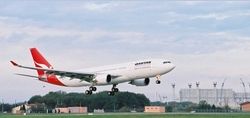Tue, Mar 27, 2012
Conventional Jet Fuel In A 50/50 Blend Fuel Derived From Waste Cooking Oil
Qantas said Monday it plans to operate Australia’s first commercial flights powered by sustainable aviation fuel on 13 April 2012.

The flights, a Sydney-Adelaide return service operated by an Airbus A330 (similar aircraft pictured), will be powered by a biofuel derived from used cooking oil (split 50/50 with conventional jet fuel). Produced by SkyNRG, the fuel has been fully certified for use in commercial aviation and endorsed by the World Wildlife Fund. Its ‘life cycle’ carbon footprint is around 60 per cent smaller than that of conventional jet fuel.
With high fuel costs and carbon pricing affecting airlines around the world, the Qantas Group is taking the lead in advocating the development of a sustainable aviation fuel industry in Australia. A 2011 study by the CSIRO, endorsed by major aviation businesses, found that such an industry is feasible and, over the next 20 years, could generate more than 12,000 jobs and decrease greenhouse gas emissions by 17 per cent in the aviation sector. However, it also identified significant obstacles that must be overcome.
Qantas’ Head of Environment, John Valastro, said the goal of the flights was to raise awareness about the potential for sustainable aviation fuel in Australia. “We know that sustainable aviation fuel can be used in commercial aviation just like conventional jet fuel,” Mr Valastro said. “But until it is produced at a commercial scale, at a competitive price, the industry will not be able to realise its true benefits. No single player can make this happen. It needs support from government, private sector investment, access to infrastructure and market demand. Over recent months Qantas has been in discussions with government and industry partners about taking the next step – producing a clear blueprint for the establishment of an Australian sustainable aviation fuel industry. This needs to focus not on speculative technologies but on biofuels that are operationally feasible now, production of which could commence within the next few years – given the right conditions.
We hope to accelerate the process in the coming weeks as we build towards this Australian-first flight.”
QF1121 will depart Sydney at 1022 local time on April 13th, arriving in Adelaide at 1205. The return flight, QF1120, will depart Adelaide at 1335, arriving in Sydney at 1600. Customers will be able to book seats on this service as they would on any other Qantas service. They will be notified at the time of booking that the flight will be powered by sustainable aviation fuel.
More News
Circle To Runway (Runway Number) Used by ATC to inform the pilot that he/she must circle to land because the runway in use is other than the runway aligned with the instrument appr>[...]
Aero Linx: National Aviation Safety Foundation (NASF) The National Aviation Safety Foundation is a support group whose objective is to enhance aviation safety through educational p>[...]
At Altitude Of About 250-300 Ft Agl, The Airplane Experienced A Total Loss Of Engine Power On November 6, 2024, at 1600 central standard time, a De Havilland DHC-1, N420TD, was inv>[...]
From 2009 (YouTube Edition): Three Hour Flight Was 'Flawless' -- At Least, Until Mother Nature Intervened For anyone who loves the aviation business, this was a VERY good day. Afte>[...]
Also: AMA Names Tyler Dobbs, More Falcon 9 Ops, Firefly Launch Unsuccessful, Autonomous F-16s The Air Force has begun ground testing a future uncrewed jet design in a milestone tow>[...]
 ANN's Daily Aero-Term (05.05.25): Circle To Runway (Runway Number)
ANN's Daily Aero-Term (05.05.25): Circle To Runway (Runway Number) ANN's Daily Aero-Linx (05.05.25)
ANN's Daily Aero-Linx (05.05.25) NTSB Prelim: De Havilland DHC-1
NTSB Prelim: De Havilland DHC-1 Classic Aero-TV: The Boeing Dreamliner -- Historic First Flight Coverage
Classic Aero-TV: The Boeing Dreamliner -- Historic First Flight Coverage Airborne-NextGen 05.06.25: AF Uncrewed Fighters, Drones v Planes, Joby Crew Test
Airborne-NextGen 05.06.25: AF Uncrewed Fighters, Drones v Planes, Joby Crew Test



